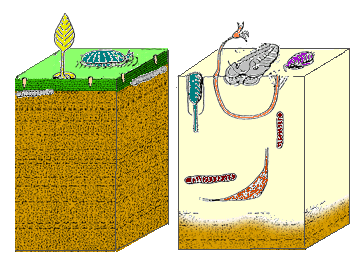
Back Revolución do substrato cámbrica Galician 캄브리아기 기질 혁명 Korean Commutatio agronomica Latin Kambriska agrara revolutionen Swedish
| Part of a series on |
| The Cambrian explosion |
|---|
 |
The "Cambrian substrate revolution"[1] or "Agronomic revolution",[2] evidenced in trace fossils, is a sudden diversification of animal burrowing during the early Cambrian period.
Before this "widening of the behavioural repertoire",[3] bottom-dwelling animals mainly grazed on the microbial mats that lined the surface of the substrate, crawling above (like how freshwater snails still do) or burrowing just below them. These microbial mats created a barrier between the water and the sediment underneath, which was less water-logged than modern sea-floors, and almost completely anoxic (lacking in oxygen). As a result, the substrate was inhabited by sulfate-reducing bacteria, whose emissions of hydrogen sulfide (H2S) made the substrate toxic to most other organisms.[4]
Around the start of the Cambrian, organisms began to burrow vertically, forming a great diversity of different fossilisable burrow forms and traces as they penetrated the sediment for protection or to feed.[5] These burrowing animals broke down and weakened the microbial mats, thus allowing water and oxygen to penetrate a considerable distance below the surface. This restricted the sulfate-reducing bacteria and their H2S emissions to the deeper layers, making the upper layers of the sea-floor habitable for a much wider range of organisms. The upper level of the sea-floor became wetter and softer as it was constantly churned up by burrowers.[1]
- ^ a b Bottjer, D.J.; Hagadorn, J.W.; Dornbos, S.Q. (September 2000). "The Cambrian substrate revolution" (PDF). GSA Today. Vol. 10, no. 9. pp. 1–9. Retrieved 2008-06-28.
- ^ Seilacher, A.; Pflüger, F. (1994). "From biomats to benthic agriculture: A biohistoric revolution". In Krumbein, W. E.; Peterson, D. M.; Stal, L. J. (eds.). Biostabilization of Sediments. Bibliotheks-und Informationssystem der Carl von Ossietzky Universität Oldenburg. pp. 97–105. ISBN 3-8142-0483-2.
- ^ S. Conway Morris, 2001
- ^ Bailey, J.V.; Corsetti, F.A.; Bottjer, D.J.; Marenco, K.N. (June 2006). "Microbially-Mediated Environmental Influences on Metazoan Colonization of Matground Ecosystems: Evidence from the Lower Cambrian Harkless Formation". PALAIOS. 21 (3): 215. Bibcode:2006Palai..21..215B. doi:10.2110/palo.2005-p05-51e. S2CID 130690224.
- ^ Seilacher, Adolf; Luis A. Buatoisb; M. Gabriela Mángano (2005-10-07). "Trace fossils in the Ediacaran–Cambrian transition: Behavioral diversification, ecological turnover and environmental shift". Palaeogeography, Palaeoclimatology, Palaeoecology. 227 (4): 323–356. Bibcode:2005PPP...227..323S. doi:10.1016/j.palaeo.2005.06.003.
© MMXXIII Rich X Search. We shall prevail. All rights reserved. Rich X Search
